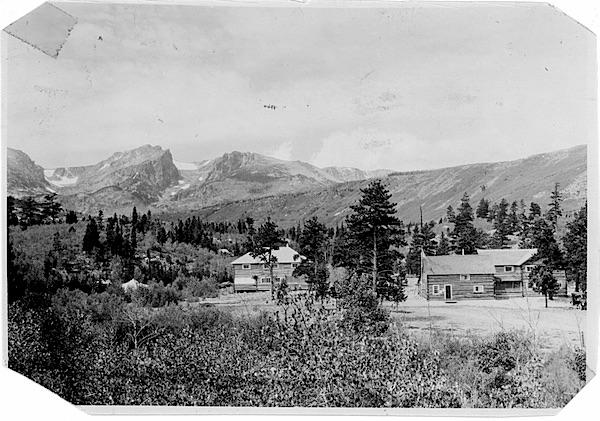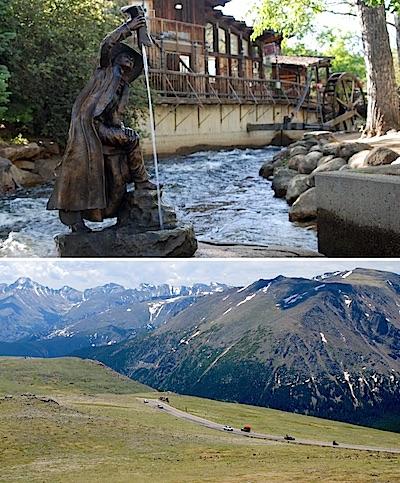
Before Rocky Mountain became a national park, Abner Sprague ran a lodge in Moraine Park/NPS archives
Editor's note: This is a special advertiser-supported article from the Essential Park Guide, Summer 2015.
Not long into the development of the world's first national park system, ranchers in and around the valley floor of Estes Park, Colorado, came to an obvious realization: keeping guests happy was easier, and more profitable, than cattle.
That conclusion, reached about 1870 or so, cast the die for Estes Park as a welcoming and awe-inspiring destination. While ranching would remain part of the town's heritage, guiding paying tourists into the mountains of today's Rocky Mountain National Park, providing them with lodging and meals, and sharing their passions for the outdoors offered residents a better livelihood than raising cows.
"One of the early settlers, I think it was Abner Sprague, he said it made more sense for him to build cabins and charge people than to give meals away for free, because he had so many people who were visiting. They would just show up and ask him if he had an extra place to stay for the night," says Brian Hoerner, curator of collections at the Estes Park Museum. "So after a couple of summers like that, a lot of those early families were like, 'Well, if this many people are going to come up here anyway, we might as well put our efforts towards making them comfortable and maybe be able to make a little more money on that than trying to have cattle or hay or raise crops."
That has remained the case for more than 100 years as Estes Park has grown up alongside the national park, which didn't arrive until 1915, or 55 years after Joel Estes put down roots with his son, Milton, in the valley that still holds his name.
Much has changed since then, however. The national park grew as private inholdings -- including now-forgotten lodges in Moraine and Horseshoe parks -- were removed by the National Park Service to allow meadow and forest to return, the Big Thompson River was dammed to create Lake Estes, and stables on Elkhorn Avenue that marked day's end for horses deployed on summer trail rides were slowly replaced by a unique variety of shops and restaurants.

From the banks of the Fall River as it flows through downtown Estes Park to the roof of the park on Trail Ridge Road, Rocky Mountain National Park makes an unforgettable vacation destination/Kurt Repanshek
Trail Ridge Road was threaded across the roof of the park and opened for travel in 1931, bringing "the whole sweep of the Rockies before you in all directions," noted then-Park Service Director Horace Albright. Today it remains as memorable a drive as it was back then, and a centerpiece in any park vacation. An example of 1930s travel through Rocky Mountain National Park will be on display in late August, when a group of Model T hobbyists will depart from Moraine Park on a 6- to 7-week-long circuit through western national parks.
Whether you travel by Model-T or Ford Mustang, Trail Ridge Road not only leads you high above tree-line, peaking at 12,183 feet, but to hiking trails that dart off across the tundra, providing ample reason to pull over and stretch your legs. Stop at the Tundra Communities Trail near the road's summit and you can take a short hike that offers spectacular panoramas, as the horizon holds Mount Chapin (12,454 feet), Sundance Mountain (12,466 feet), Terra Tomah Mountain (12,718 feet), Mount Julian (12,928 feet), and Specimen Mountain (12,489 feet).
For some park visitors, climbing is another key aspect to a Rocky Mountain National Park vacation. Since 1868, when a surveying party accompanying John Wesley Powell reached the summit of Longs Peak, more than 10,000 people are thought to have stood atop the 14,259-foot-tall crag. Such a climbing record has made Estes Park a Mecca for climbers, and generated more than a little history.
"We have world-class climbers who come here just because of our climbing and atmosphere," says Derek Fortini, the museum director and curator of exhibits. "We were able to explore that through an exhibit. Estes Park was one of the very first places in North America, besides up in Canada, where you could actually hire a guide to take you up a mountain, which of course was Longs Peak."
Visit town in late June and on the 29th you can learn some of that lore during the final installment of the Climbers' Oral History Project presented at the Estes Park Museum in conjunction with the museum's "Climb On!" exhibition. Or join the Colorado Mountain Club on a guided climb to the top of Longs Peak or to one of 100 of the other named peaks in the park this summer.
Throughout the summer memorable tours and talks will be hosted by the Estes Park Museum. Some will take you to sites where lodges long ago stood in the park's landscape, where convicts were housed while building Fall River Road, and even where a resort complete with 9-hole golf course, driving range, and swimming pool stood in Moraine Park.
"The idea of these historic tours is to get people to realize that people lived in that land, people worked that land, people died in that land, and are buried in that land. There's a lot going on when you start to look at the history of it, compared to the serene experience that most people see now," Mr. Fortini says.
Of course, the summer's highlight comes September 4th, when the rededication celebration of Rocky Mountain National Park takes place. This special event brings together local and national speakers at the Glacier Basin Campground to celebrate both the national park's past, and its future. Learn more about these and other Rocky Mountain National Park Centennial programs and events at VisitEstesPark.com/Centennial.

 Support Essential Coverage of Essential Places
Support Essential Coverage of Essential Places







Comments
A wonderful park that offers a range of great resources and experiences. All of us who get to enjoy the park today can be thankful for those who worked to establish the park a century ago. One of the biggest challenges for the coming years will be dealing with the 4 million or so people (and growing) who live close enough to make a day trip Rocky Mountain.